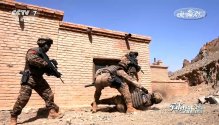You are using an out of date browser. It may not display this or other websites correctly.
You should upgrade or use an alternative browser.
You should upgrade or use an alternative browser.
PLA Ground Forces news, pics and videos
- Thread starter Jeff Head
- Start date
plawolf
Lieutenant General
My point wasn't that it's not useful, it's that missile costs don't scale linearly. If you're paying say 75% of the cost of a javalin sized guided missile, why not go for the bigger bang.
The main advantage of QN-202 would be its portability, where a single soldier can carry 6? Missiles.
Several reasons spring to mind:
- Number of rounds you can carry. How many more rounds of QN202 can you carry for every Javalin size and weighted missile? Making the QN202 bigger for more bang just reduces the number of shots you have, which is counterproductive if the original smaller missile was already sufficiently for the intended role.
- Ease of resupply. The PLA are doing a lot of work on using drones for logistics support, and the QN202 looks like it was designed with drone resupply in mind. Think of the massive benefits that would bring.
- Speaking of drones, the QN202 could also very easily be adapted for use on medium sized drones to give them hunter killer capabilities. Having a common round would massively ease logistics and reduce unit cost of rounds. The development might have even started as a dual track system for UAV and infantry use from the get go.
- Operating position. With a big missile like a Javalin, you need to shoot it outside or else you are going to take some serious backblast. Smaller missiles might allow you to shoot from inside buildings for better cover and survivability in the face of enemy UAC and FPV threats.
- Shooter signature: a big missile will be much more likely to be detected by the enemy, both in terms of direct attack against your missile team, but also in terms APS against the missile itself. With a small enough missile, it might be able to slip blow the trigger threshold for enemy APS defences.
This guy ate a can of beef from 1899.A review of the type-11 (2011) MRE, posted by a guy who exclusively reviews MREs from around the world.
FriedRiceNSpice
Major
He could've just gone to McDonalds.This guy ate a can of beef from 1899.
- Operating position. With a big missile like a Javalin, you need to shoot it outside or else you are going to take some serious backblast. Smaller missiles might allow you to shoot from inside buildings for better cover and survivability in the face of enemy UAC and FPV threats.
It's not the size of the missile per se but the launch method that determines the ability to be launched from an indoor firing position.
Many AT missiles, Javelin included, can definitely be shot from an indoor position. Soft launching via a small kickout charge means there is limited backblast/signature within the indoor space it is fired from. Other such missiles include Spike, HJ-12, Pzf 3 and even the ubiquitous RPG-7
Another type is the encapsulated blast launcher like the Matador - designed to be low signature and fired from indoors.
Ehhh idk. Then again, pretty much 95% of all fancy CQB tactics, including the room clearing drills and etc practiced in western SOF clearly won't apply to modern combat. If you look at real CQB combat it's almost nothing like any of the pre-prepared drills. But it's good that they're experimenting with new tactics though.
I've never seen western SOF do this tricky move in CQB training, but I think you're right…Ehhh idk. Then again, pretty much 95% of all fancy CQB tactics, including the room clearing drills and etc practiced in western SOF clearly won't apply to modern combat. If you look at real CQB combat it's almost nothing like any of the pre-prepared drills. But it's good that they're experimenting with new tactics though.
It's because these guys are wearing incredibly light gear. They have no plates, breaching equipment, comms, NVG's, and other necessary equipment. Their loadout is similar to or lighter than that of an American patrol officer with a rifle who is serving a dangerous warrant. In addition, these guys shouldn't be compared to SOF in general since their tasks are completely different.I've never seen western SOF do this tricky move in CQB training, but I think you're right…
Last edited:






